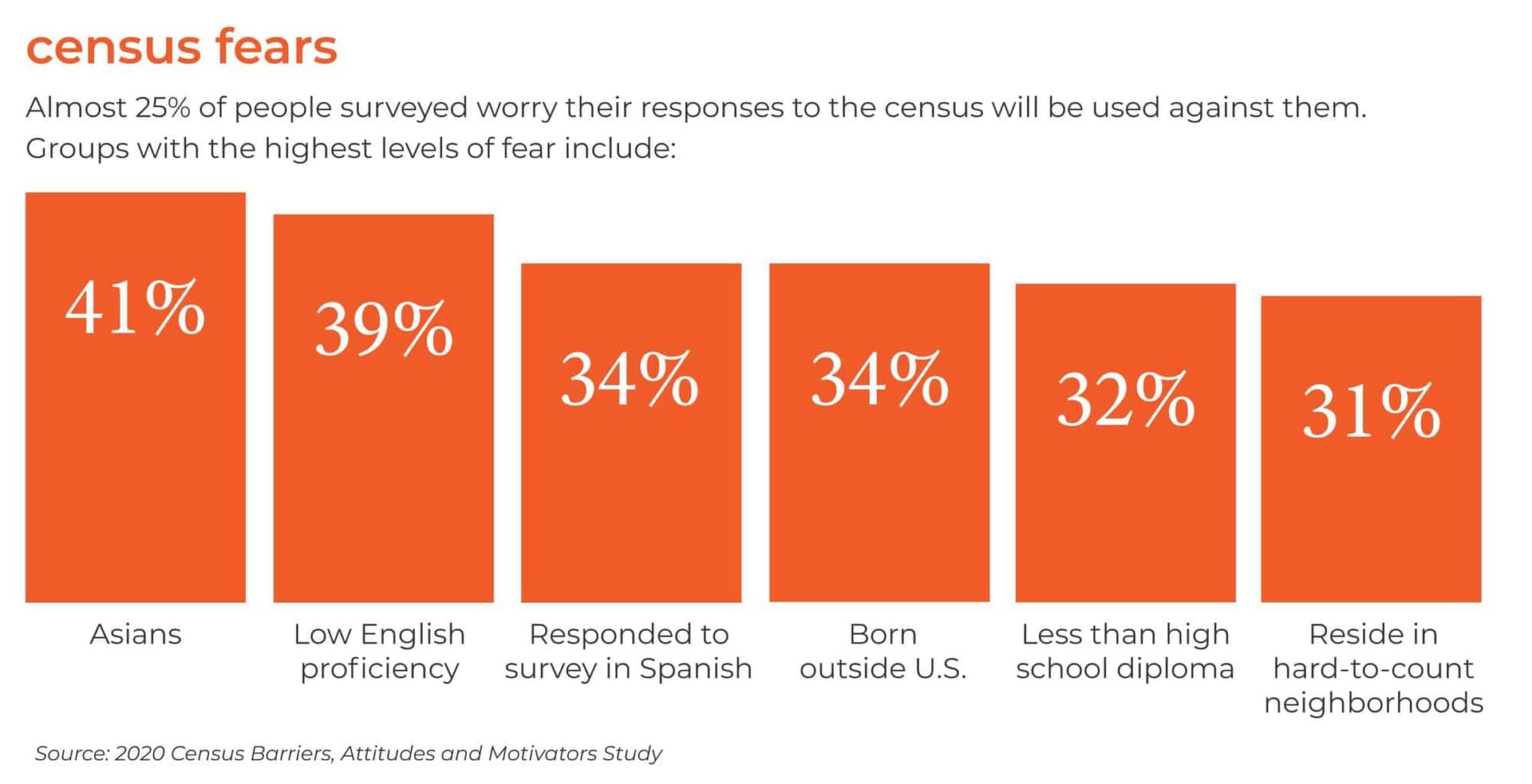The U.S. Census—Giving Everyone an Equal Vote
This spring, a ten-minute, nine-question survey—the U.S. census—will determine the extent to which U.S. residents are fairly and accurately represented by their government.
The crucial process of counting every person living in the country is one of the most important civil rights issues today. Historically, census data has not adequately represented many vulnerable demographics, including people of color, low-income households, and young children. And now, the census faces a pandemic during the peak of its operations.
In this article, we look at why undercounts are such a problem, and ways underrepresentation can be mitigated through outreach and language access. We also share the tactics New York City is taking to encourage every person in the five boroughs to participate in the count.
How 9 Census Questions Shape the Trajectory of Our Country
The census is the largest peacetime mobilization undertaken by the federal government. By constitutional mandate, all individuals (both citizens and non-citizens) living in the U.S. are to be counted every 10 years. In addition to ensuring fair representation, the census compiles vital information about the changing needs of the people living in our country and informs the allocation of resources (dollars and people) to federal programs. Census data is used to determine the apportionment of more than $650 billion in federal funds for critical programs and services, including public education, public housing, social services, and infrastructure such as roads and bridges.
How Does the U.S. Census Bureau Collect Data?
In March, the U.S. Census Bureau invited every household to participate in the census survey, which is available in 13 languages. While it was once necessary for clipboard-carrying census takers to visit homes across the country, there are now multiple ways to submit the questionnaire. For the first time ever, the bureau is permitting people to answer online. While most questionnaires are expected to be submitted digitally, people also have the option to respond by phone or mail.
What Is the Purpose of the U.S. Census and What’s at Stake?
One person, One vote
The census affects the balance of power. Population counts determine how the 435 voting seats in the House of Representatives will be apportioned across the states. Final counts will be published by December 31, 2020 to decide how many seats each state will be allocated in the 2022 U.S. House elections. Results will also inform the number of votes each state will have in the 2024 electoral college.
In addition, census totals are used to adjust or redraw electoral districts, based on where populations have increased or decreased. Redistricting is intended to ensure that each person’s voting power is roughly equivalent—adhering to the one-person, one-vote rule. Redistricting data from the 2020 census will be published within one year of Census Day, by no later than March 31, 2021.
Allocation of Funds
The census informs the amount of funding the federal government allocates to state governments and local communities. Counts impact the distribution of funds for public hospitals, education, transportation, and affordable housing. This includes planning and funding for:
- Healthcare—including programs such as Medicaid, Medicare Part B, State Children’s Health Insurance, and the prevention and treatment of substance abuse.
- Education—including Head Start, Pell Grants, school lunches, rural education, adult education, and grants for preschool special education.
- Infrastructure—including programs for highway planning and construction, Section 8 housing, federal transit, community development, and rural water and waste disposal systems.
- Employment and Training—including programs for vocational rehabilitation state grants, dislocated workers, and American Indian and Alaska Native employment and training.
Investments in Communities
Census data helps businesses understand community needs. Companies use demographic information to make decisions about investment strategies, and the data can impact decisions about whether or not to do business in a particular community. Census responses can potentially impact economic growth and job creation in communities.
Let’s Chat!
Get in touch to speak with a member of our team.
Who’s Missing? Omissions and Underrepresentation
Underrepresentation is a big problem. In the 2010 census, there were nearly 16 million omissions (people who should have been counted, but were not).1 Unfortunately, the people who most need community resources are often the most reluctant to participate. According to Census Bureau research, the groups most underrepresented in the census include minorities, foreign-born residents, renters, low-income individuals, the homeless, and children under the age of five.2
The reasons are varied and complex. People who have low incomes, especially people of color, are more likely than others to live in nontraditional or multi-family dwellings, rent their homes, and move more frequently, all of which makes it harder for the Census Bureau to locate and count them.
Then there’s the heightened environment of suspicion, misinformation, and distrust. By law, the Census Bureau cannot share personal information with other agencies. The information collected cannot be used for any purpose other than statistical ones, and it cannot be used to harm the people who provide their information. Despite the legal protections, many people will still be reluctant to participate. Some are not aware of their rights; others mistrust the government and do not believe their data will be protected.
The proposed citizenship question didn’t help matters. While the Supreme Court has prevented the addition of a citizenship question, many believe that irreparable harm has already been done. Concerns about deportation are still likely to keep noncitizens from participating, whether they are in the country legally or not. Many incorrectly believe a citizenship question is on the questionnaire. The Census Bureau, which conducts more than 100 surveys for the federal government, continues to ask about citizenship on other forms, which has added to the confusion.
People with low English proficiency are especially at risk for believing that their census data will be used against them. In 2017, the Center for Survey Management conducted multilingual focus groups to study the doorstep messages enumerators can use to overcome reluctance in responding to the 2020 census. Focus groups were conducted in English, Spanish, Chinese, Korean, Vietnamese, Russian, and Arabic. Serious concerns about the confidentiality of data, including between agencies, negative perceptions of immigrants, and deportation emerged across languages in this project.3
One way to mitigate the misinformation and distrust is through effective communication. Informing people of their rights, and doing so in the language they understand, will help allay the spread of misinformation. Educational campaigns, translated into the languages spoken by residents, can help clear up some of the confusion and alleviate the fears of those who speak other languages.
How the Coronavirus Pandemic Is Impacting the Census
The coronavirus has thrown an unexpected wrench into census operations. The Census Bureau relies on enumerators going door to door to track down the millions of residents who fail to fill out forms or are unable to receive them by mail. But now, human interaction is exacerbating the spread of the pandemic. And some of the groups at highest risk for coronavirus infection are also groups that enumerators must contact in person. This includes seniors in assisted living facilities, students residing on college campuses, and people living on the streets or in homeless shelters.
The original plan went like this:
- March 30-April 1: Census Bureau works with community-based organizations to count the homeless.
- April 9: Enumerators target residential college students before they leave for the summer.
- Mid-May: Enumerators begin going door to door contacting residents who have not yet responded.
- July 31: Completion date for data collection.
The Census Bureau has since modified its schedule. As of early April, field operations were suspended for two weeks. The deadline for completion of the count has also been extended into mid-August. And if widespread quarantines continue, the Census Bureau will likely further shift its timeline and strategy.
The pandemic may also impact the Census Bureau’s ability to hire the appropriate number of enumerators. While the Census Bureau aims to hire 500,000 workers by late May, census job fairs and other in-person hiring events have been cancelled. And while social media campaigns are encouraging job seekers to apply online, some lawmakers and civil rights leaders are concerned that the government will not be able to hire the needed staff.
Featured Services
Learn more about…
How New York City Is Encouraging Residents to Stand up and Be Counted
Throughout the country, state and local governments along with community-based organizations are making efforts to ensure widespread participation in their communities. New York City is leading the charge with the nation’s largest municipal coordinated census campaign.
In 2010, only 62% of New Yorkers self-responded to the census, way below the 76% national average. According to early Census Bureau predictions, this year’s response rate was expected to be even lower at 58%.
Even before the coronavirus spread, New York presented a range of challenges:
- Almost 40% of New Yorkers are foreign-born
- 200+ languages are spoken throughout the five boroughs
- Historical distrust of government in communities of color
- Fear and disinformation have been spread by the now-defunct citizenship question
- Complex and varied residential infrastructure
- Historically low turnout rates
The city’s immigrants, minorities, and low-income individuals have the highest risk of being undercounted. However, these are the groups that stand to suffer most due to the potential loss of resources. In an effort to obtain a more accurate census count, the city approved a $40 million, multi-pronged initiative. The majority of that funding, $23 million, was allocated to community-based organizing and outreach, making it the largest such investment by any city in the nation.4
The Complete Count Fund, a joint project of NYC Census 2020, the New York City Council, and the City University of New York, selected 150 community-based organizations to receive “get out the count” funding. These organizations serve 245 neighborhoods across the five boroughs, in 80 languages.
The city invested $3 million in community and ethnic media advertising to ensure participation among the city’s most historically undercounted communities. Using brochures, fact sheets, commitment cards, videos, and digital ads, the campaign explains why it’s so important for New Yorkers to participate in the census, and asks residents to pledge their participation. To reach all New Yorkers, the census campaign is advertising its message in up to 22 languages. Eriksen supports the city’s efforts by translating campaign components so the critical messaging can reach non-English speakers throughout the five boroughs.
The pandemic has forced the city to drastically alter its outreach strategies. Events, street canvassing, and door-to-door campaigns have been cancelled. Town halls, teach-ins, and phone- and text-banking will all be conducted remotely, using video conferencing whenever possible. Essential service providers are also helping to get out the message. United Way is including a census reminder in messages sent via Plentiful, an app that informs people of neighborhood food pantries. Health care providers like Somos Community Care, which serves Medicaid recipients, are also spreading the word.
Get out the Count
While cities around the country struggle to treat the influx of Covid-19 patients, the importance of the census is underscored. Population data collected by the census informs critical funding for hospitals, healthcare services, and Medicaid as well as future planning for situations like COVID-19. Through the census, we invest in people’s health, welfare, and well-being.
At Eriksen, we applaud the efforts New York City and other state and local governments across the country are making to ensure that all people are counted. We are proud to provide translation services to support New York City’s get-out-the-count efforts and help their important messaging resonate across languages. At a time when the pandemic is on every media outlet, it’s a challenge to raise awareness about the census—but ensuring representation for the people most in need is now more essential than ever.
 Named to the 2024 Inc. 5000 list of fastest-growing companies and ranked among the world’s top 100 language service providers by CSA Research
Named to the 2024 Inc. 5000 list of fastest-growing companies and ranked among the world’s top 100 language service providers by CSA Research


